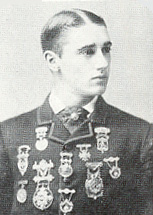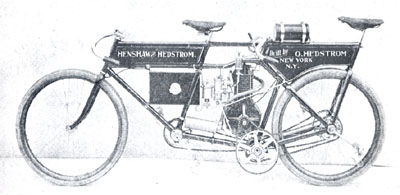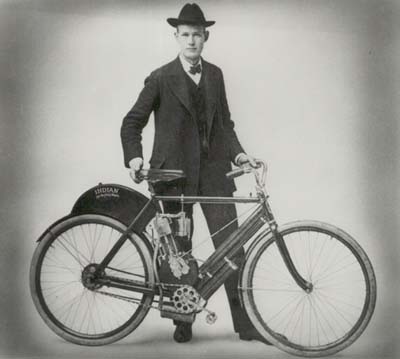by Daniel K. Statnekov |
| ©1998 - 2006 Daniel K. Statnekov |
By 1908, however, some of the longer bicycle tracks began to feature the motor-powered cycles. Even so, the board tracks were narrow, and competition was limited to a race between only two machines at a time. This changed in March of 1909 when John Shillington Prince, a former high-wheel bicycle world champion, opened the Coliseum motordrome in Los Angeles. At 3&1/2 laps to the mile, the new Coliseum was nearly twice as long as the velodromes and provided a circular, wooden speedway that could handle the 60 to 70 mile per hour speeds that the riders could coax from their otherwise stock machines.
Almost immediately, the spectacle of men hurtling at "break-neck" speeds around the new motordromes became a passionately attended spectator sport. Huge crowds thronged to the board tracks that seemed to spring up overnight in cities across the country. This did not go unnoticed by the co-founders of the largest motorcycle producer of the day, the Hendee Company, manufacturer of the Indian "Motocycle." Both George M. Hendee and Carl Oscar Hedstrom understood the publicity value that racing brought to their enterprise. Before joining forces, the two partners had had extensive experience in the two-wheeled sport.

George Hendee
Hendee had won the National Amateur High Wheel Championship of the United States in 1886 and held the title until 1892. After retiring from professional racing in 1895, the former champion continued to be involved in the bicycle trade, and in 1897 he established his own manufacturing firm in Springfield, Massachusetts.
"Oscar" Hedstrom had also started out as a bicycle builder and amateur racer, and had been a star rider in the 1890�s. A skilled machinist and pattern maker by trade, Hedstrom specialized in custom-built machines that were popular with professional racing men in the New York area. Like Orient�s Charles Metz, Oscar Hedstrom�s interest in building a practical motorcycle was ignited when he built a motorized pacing machine for use on the bicycle tracks

Hedstrom's Tandem Pacer
At a race at Madison Square Garden in 1900, George Hendee first observed the use of the motorized tandem and was impressed with the performance and reliability of Hedstrom's machine. At their first meeting, Hendee proposed building a light road machine for everyday transportation that would free the rider from the drudgery of pedalling. This was in line with Hedstrom's own thinking and the two men became partners on the spot.
By early Spring of 1901, the first Indian "Motocycle" was ready for a road test, and before the year was out the Hendee Company had already sold several machines to the public. The following year the Springfield company entered three of their "motocycles" in the rigorous Boston to New York endurance run. All of the Indian entries completed the distance, each finishing with a perfect score. The publicity that resulted from this was helpful, and by the end of the year the company had rung up sales for more than a hundred machines.

Oscar Hedstrom
The two partners continued to field entries in various sporting events, and their success was rewarded with even more publicity. Within a short time the fledgling company had more orders than they could fill. For the next five years the Hendee company continued to make progress. Although racing continued to be an important component of their success, the primary focus of the partners efforts was concentrated on their standard production machines which they sold in ever-increasing numbers.
The Indian sales catalog for 1908, however, broke with tradition and included a production model designed solely for racing. Available in both single and twin cylinder versions (Indian had added a twin to their line the previous year), the new machine featured a torpedo-shaped tank clipped to the top frame tube, and a saddle that allowed the rider to assume a crouched position for racing. The new model had been designed to keep Indian in the lead: in the marketplace and on the race track as well.
source : http://www.statnekov.com






0 comments:
Post a Comment